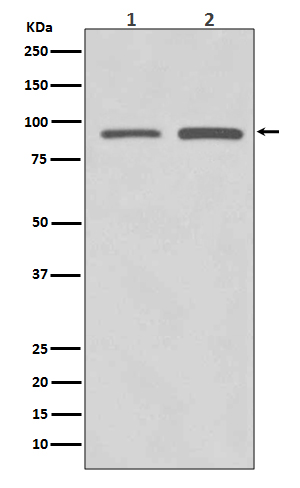Anti-SUZ12 Rabbit Monoclonal Antibody
- SPECIFICATION
- CITATIONS
- PROTOCOLS
- BACKGROUND

Application
| WB, IF, ICC, IP |
|---|---|
| Primary Accession | Q15022 |
| Host | Rabbit |
| Isotype | Rabbit IgG |
| Reactivity | Rat, Human, Mouse |
| Clonality | Monoclonal |
| Format | Liquid |
| Description | Anti-SUZ12 Rabbit Monoclonal Antibody . Tested in WB, ICC/IF, IP applications. This antibody reacts with Human, Mouse, Rat. |
| Gene ID | 23512 |
|---|---|
| Other Names | Polycomb protein SUZ12, Chromatin precipitated E2F target 9 protein, ChET 9 protein, Joined to JAZF1 protein, Suppressor of zeste 12 protein homolog, SUZ12, CHET9, JJAZ1, KIAA0160 |
| Calculated MW | 83055 MW KDa |
| Application Details | WB 1:500-1:2000 ICC/IF 1:50-1:200 IP 1:50 |
| Subcellular Localization | Nucleus. |
| Tissue Specificity | Overexpressed in breast and colon cancer.. |
| Contents | Rabbit IgG in phosphate buffered saline, pH 7.4, 150mM NaCl, 0.02% sodium azide and 50% glycerol, 0.4-0.5mg/ml BSA. |
| Clone Names | Clone: IEB-19 |
| Immunogen | A synthesized peptide derived from human SUZ12 |
| Purification | Affinity-chromatography |
| Storage | Store at -20°C for one year. For short term storage and frequent use, store at 4°C for up to one month. Avoid repeated freeze-thaw cycles. |
| Name | SUZ12 |
|---|---|
| Synonyms | CHET9, JJAZ1, KIAA0160 |
| Function | Polycomb group (PcG) protein. Component of the PRC2 complex, which methylates 'Lys-9' (H3K9me) and 'Lys-27' (H3K27me) of histone H3, leading to transcriptional repression of the affected target gene (PubMed:15225548, PubMed:15231737, PubMed:15385962, PubMed:16618801, PubMed:17344414, PubMed:18285464, PubMed:28229514, PubMed:29499137, PubMed:31959557). The PRC2 complex may also serve as a recruiting platform for DNA methyltransferases, thereby linking two epigenetic repression systems (PubMed:12351676, PubMed:12435631, PubMed:15099518, PubMed:15225548, PubMed:15385962, PubMed:15684044, PubMed:16431907, PubMed:18086877, PubMed:18285464). Genes repressed by the PRC2 complex include HOXC8, HOXA9, MYT1 and CDKN2A (PubMed:15231737, PubMed:16618801, PubMed:17200670, PubMed:31959557). |
| Cellular Location | Nucleus Note=Localizes to chromatin as part of the PRC2 complex |
| Tissue Location | Overexpressed in breast and colon cancer. |

Thousands of laboratories across the world have published research that depended on the performance of antibodies from Abcepta to advance their research. Check out links to articles that cite our products in major peer-reviewed journals, organized by research category.
info@abcepta.com, and receive a free "I Love Antibodies" mug.
Provided below are standard protocols that you may find useful for product applications.
If you have used an Abcepta product and would like to share how it has performed, please click on the "Submit Review" button and provide the requested information. Our staff will examine and post your review and contact you if needed.
If you have any additional inquiries please email technical services at tech@abcepta.com.













 Foundational characteristics of cancer include proliferation, angiogenesis, migration, evasion of apoptosis, and cellular immortality. Find key markers for these cellular processes and antibodies to detect them.
Foundational characteristics of cancer include proliferation, angiogenesis, migration, evasion of apoptosis, and cellular immortality. Find key markers for these cellular processes and antibodies to detect them. The SUMOplot™ Analysis Program predicts and scores sumoylation sites in your protein. SUMOylation is a post-translational modification involved in various cellular processes, such as nuclear-cytosolic transport, transcriptional regulation, apoptosis, protein stability, response to stress, and progression through the cell cycle.
The SUMOplot™ Analysis Program predicts and scores sumoylation sites in your protein. SUMOylation is a post-translational modification involved in various cellular processes, such as nuclear-cytosolic transport, transcriptional regulation, apoptosis, protein stability, response to stress, and progression through the cell cycle. The Autophagy Receptor Motif Plotter predicts and scores autophagy receptor binding sites in your protein. Identifying proteins connected to this pathway is critical to understanding the role of autophagy in physiological as well as pathological processes such as development, differentiation, neurodegenerative diseases, stress, infection, and cancer.
The Autophagy Receptor Motif Plotter predicts and scores autophagy receptor binding sites in your protein. Identifying proteins connected to this pathway is critical to understanding the role of autophagy in physiological as well as pathological processes such as development, differentiation, neurodegenerative diseases, stress, infection, and cancer.


